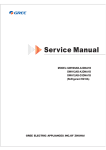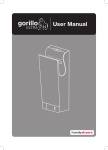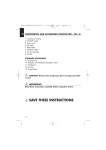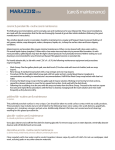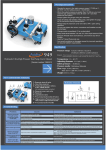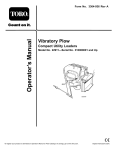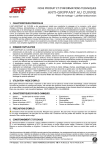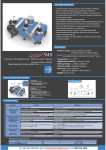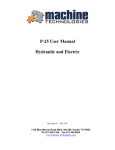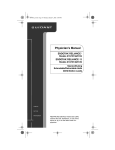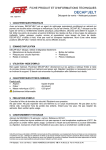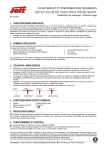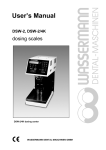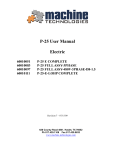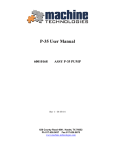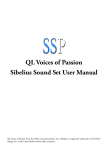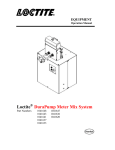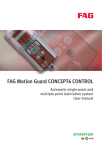Download User Manual
Transcript
SPR 8 OPERATION MANUAL Ropka tee 28 Tartu ESTONIA WWW.spraytec.ee [email protected] 1. INTRODUCTION Spray unit SPR 8 is an airless high-pressure device for spraying of finishing plasters, viscous paints and adhesives with a maximum grain size of 0.2-0.3 mm. The device can be used to spray both ready-made putty and putty mixed on-site from powder. The spray unit includes a bag wringer for emptying of ready-made putty bags. Benefits of an airless high-pressure spray • no compressed air is needed; • less dust is generated while spraying; • a light and comfortable hose and plaster gun; • low noise level; • simple to operate. 2. SAFETY REQUIREMENTS 2.1. You must read the user manual prior to putting the device into operation. 2.2. Only a properly trained operator can use the device. Contact the company that sold you the device for information about terms and conditions of such training. 2.3. Only a properly trained specialist can perform maintenance of the electrical system of this device. 2.4. When the device is in operation, no irrelevant persons must be allowed near it. 2.5. The device must be operated in compliance with all requirements listed in this user manual. 2.6. During operation of the device the employees using it must precisely agree on the division of their functions. 2.7. If the device is not in the same room as the spraying operator, (she)he must be notified about container filling and other actions performed with the device. 2.8. Only materials specified for the purpose can be used for spraying. If necessary, address your questions to the material manufacturer. 2.9. Means of protection (goggles, gloves, proper work clothing) must be used when operating the device. 2.10. Never point the spray gun at people! 2.11. Having completed the work, release pressure from the hose and the spray gun and lock the spray gun trigger, follow the instructions in the user manual (see point 6.10). Do not leave the pressurised device unsupervised! 2.12. If the spray tip of the gun becomes clogged, follow the instructions in the user manual (see point 7.5). 2.13. Prior to putting the device into operation make sure that its hose, spray gun, tip and other parts are securely attached. 2.14. When connecting the unit to the power supply ensure that all network parameters meet the requirements stipulated in the user manual and technical data. 2.15. The device can only be connected to the electrical grid using such components that comply with the manufacturer’s technical specifications. If different standards are in use, please contact the product seller. 2.16. In case of an emergency, stop the unit immediately and disconnect the power cable of the unit from the power supply. 2.17. Before performing maintenance and repair work the unit must be disconnected from the power supply. 2.18. For the duration of the device maintenance and repairs you must release pressure from the hose and the pump (see point 7.5). 2.19. Put the cover on the device container to prevent external items from falling into the container. 2.20. Clean the device in due time! 2.21. Perform device maintenance and repairs in accordance with the recommendations listed in the user manual. Address any questions you may have to the seller company. 2.22. When repairing the device, use original spare parts to ensure safe device operation and preserve its warranty. 2.23. Have the seller company take care of larger-scale repairs. 3. TECHNICAL DATA Motor 2,2 kW Electrical requirement 230 V, single phase Fuse 16 A Speed by frequency inverter changeable Capacity 4-8 l/min Pump pressure Max 80 bar Hose 5/8” 15 m Nozzle standard 647 possible 541-651 Container volume 56 l Length 1200 mm Hight 950 mm Width 590 mm Weight 80 kg 4. STANDARD DELIVERY 1. device SPR8 2. material hose 5/8” 15 m 3. spray gun SP25.000 4. nozzle 647 5. bag wringer 5. DESCRIPTION OF THE UNIT The housing of the unit is made from stainless steel and the housing of the bag wringer is made from glass fibre. The materials used ensure long-term durability of the unit. For comfortable transportation the unit is equipped with large pneumatic tyres and handles, which can be turned downwards to reduce the overall measures of the unit. The main assembly units of a plaster spray are the housing of the unit, a transmission system, an electrical system, a valve system, a hose with a spray gun and bag wringer. The transmission system consisting of a reduction gear unit, cardan shaft and screw pump with fastening elements. The system use a screw pump for generating pressure. The valve system consisting of a ball valve, a pressure release valve , a manometer and a pressure sensor. The pressure sensor starts and stops the unit automatically. The manometer monitors the pressure of the material. The electrical system of the unit consists of an electric box with control buttons and a frequency inverter. A frequency inverter makes it possible to easily adjust the output of the unit. The function of a bag wringer is to press the ready plaster bags empty. 6. HIGH PRESSURE SYSTEM DEVICE START-UP 6.1. Place the device on a horizontal surface in the area where the work is taking place so that there is access to the controls on the device and so that it is as convenient as possible to fill the device with material. When installing the power cable, make sure it isn’t in the way of other employees on the site. 6.2. Visual inspection of the device • make sure the hoses are securely fastened; • make sure there are no unnecessary parts in the material container; • the reversing switch (figure 2, pos. 3) on the cover of the electric box must be in position 0; • turn the speed adjustment knob (figure 2, pos. 2) on the cover of the electricbox to position 50. 6.3. Install the necessary tip on the spray gun. The recommended tips are 645-647-651. Follow the advice of the manufacturer of the material. 6.4. Fill the container with the material. To empty the bag of putty, turn the bag wringer roller to the rear position, place the bag on the bag wringer with the bottom toward the roller. Turning the roller shaft, squeeze the bag end between the roller and the chassis of the wringer. Holding on with one hand to the bag handle, cut the bag open right underneath the handle. Turning the roller shaft, squeeze the bag until empty. Turn the roller shaft back into the rear position and remove the empty bag. Depending on the bag volume, 3-4 bags of material will fit in the container. During the operation, keep constantly track of the amount of material in the container, and add material if needed. 6.5. Connect the power cable to the mains power with 16 A line protection. 6.6. Before starting up the device for the first time, as well as after changing the tips, the spray pressure and switch-off pressure have to be adjusted. It is easier to make the adjustments with two people. One worker sprays and the other makes the needed adjustments. 6.7. When turning on the device, turn the reversing switch (figure 2, pos. 3) to position 1 and press the spray gun’s trigger . 6.8. The device will start and the pressure will start rising. When the manometer (figure 3, position 11) shows pressure under 75-80 bar, increase the material’s pressure by increasing the device rotation speed, turn the speed adjustment knob (figure 2, position 2) slowly clockwise. After turning the knob, there will be a lag time before the pressure rises. If you have increased the pressure beyond 80 bar, immediately lower the pressure by turning the knob anti-clockwise. It is prohibited to operate it at a higher spray pressure than 80 bar, as this will result in very rapid wear on the screw pump. Keep an eye constantly on the spray pressure (the manometer figure 3, pos. 11) and if needed, perform an adjustment. 6.9. When you have achieved the right spray pressure, release the spray gun trigger. The device must switch off immediately at a pressure of 85-90 bar. If the pressure rises higher, the device’s switch-off pressure must be adjusted. The switch-off pressure can be regulated by turning the manual nut on the pressure sensor (figure 3, pos. 10). For stabilising the position of the nut there is a locknut that has to be loosened before making the adjustment, and then secured again after the adjustment. If you turn the nut clockwise, the device will switch off at a higher pressure, and if you turn it anticlockwise, the switch off pressure will fall. The pressure adjustment has to be repeated several times to achieve the optimum result. If you turn the pressure too high, some of the material will ooze out through the screw pump back into the container. This will increase wear on the pump. Use of different materials may result in a need to make adjustments. 6.10. When halting the device for a short interval, turn the reversing switch (figure 2, position 3) into position 0; by pressing the spray gun’s trigger, release the pressure on the system. Lock the spray gun trigger using the safety. 7. RECOMMENDATIONS FOR SPRAYING 7.1. If the application of the spray becomes uneven, stop the device. Turn the spray nozzle 180 degrees (anti-clockwise) and depress the trigger of the spray gun for an instant. The device will start up, some of the material will flow through the tip, flushing it. Release the trigger and turn the spray nozzle back (clockwise) into operating position. 7.2. If the spray nozzle clogs very frequently, try a larger tip. 7.3. Try to keep plaster removed from the wall from getting into the device container. The used and removed material may contain larger particles, which will clog the tip. 7.4. If the spray pressure is not sufficient for a proper spread, try a smaller tip. 7.5. If the device clogs and also when replacing the tip, there may be a need to decrease the pressure in the material hose. To do so, use the pressure release valve (figure 3, pos. 22. 23). To open the valve, unscrew the valve knob (figure 3, pos.23), the material will flow out from the opening in the valve body. 7.6. Keep track of the spray pressure on the manometer (figure 3 pos.11), and if necessary adjust it. 7.7. In case the unit stops after the spray gun trigger has been released and shortly after re-starts for a moment by itself, a ball valve must be cleaned (figure 3 pos.20). Disconnect the unit from the power supply, press the spray gun trigger and let the material under pressure out from the system. To remove residual pressure remaining in the system, open the pressure release valve (figure 3, pos. 23). After having ensured that the system is not under pressure any longer, remove the plaster hose from the unit. Next unscrew the valve (figure 3, pos. 13) and remove the spring from the valve (figure 3, pos. 21) and ball (figure 3, pos. 20). Clean the ball valve housing (figure 3, pos. 12 ) and all disassembled elements. Check the condition of the ball and ball seating (figure 3, pos. 15, 16). If needed replace the elements. In connection with the above the pressure releasing valve should also be cleaned. Unscrew the pressure releasing valve knob (figure 3, pos. 23) and remove the ball (figure 3, pos. 24). Clean the valve channels. Assemble the elements in reverse order. 8. CLEANING 8.1. In the course of operation, clean the bag wringer constantly to keep dry material from accumulating there. It is easiest to use a damp sponge. Keep the exterior surface of the device clean as well. It is not allowed to clean the device by pressure washing, as the stream of water may damage electrical components. 8.2. When you are done working, clean the device. Clean the container’s inside walls with a damp sponge. Pour about a 1 cm layer of clean water on to the material and cover it with plastic film. 8.3. Wash the spray gun tip and tip holder separately. You can place the spray gun’s end in water. 8.4. If there is a longer pause in work (a week or more) the container should be emptied of material and cleaned. Pump the contents of the container out, unplug the device from the mains power and wash the container out. Pump the contents of the container out. To keep the pump from getting stuck, some conservation fluid should be added to the pump, e.g. glycerine. Don’t leave the pump standing in water, as this will cause corrosion of the motor and it will be very hard to start. In the case of breaks of several days, it is advisable to leave some material in the device, pour some water in and cover with film. 8.5. If there is a danger of the device freezing, all of the liquid should be drained from the device. Hoses can be cleaned with pressurised air. It is recommended to dismantle the pump from the device and screw the rotor out of the stator. 8.6. From time to time, the ball valve of the device will have to be cleaned (see point 7.7). 9. MAINTENANCE 9.1. The seals (figure 4 pos. 3, 5, 6) on the shaft boot of the reduction gear unit (figure 4 pos. 4) have to be kept lubricated. The lubrication nipple is located under the electrical box on the mounting plate of the reduction gear unit (figure 4 pos 1). Use a lubricator. Fill it until you see lubricant oozing out in the container between the seal and the shaft boot of the reduction gear unit. Lubrication should be done twice a week. Waterproof lubricants are suitable. 9.2. The pressure sensor (figure 3 pos. 10) hose (figure 3, pos. 9) must be filled with lubricant. From time to time, lubricant should be added, using the same lubricant you used to lubricate the shaft boot of the reduction gear unit. Remove the hose from the device, screw the lubrication tool included with the device into one end of the hose. Pump the lubricant using the lubricator until clean lubricant emerges from the other end of the hose. Reassemble the hose. 9.3. Axial play between the rotor of the pump (figure 4, pos. 12) and cardan shaft (figure pos. 11) shall be 2-3 mm. Play can be adjusted by means of a support (figure 4, pos. 7). Briefly start the unit with an empty tank. To do this, turn the reversing switch (figure 2, pos. 3) to position 1. Stop the unit. Release the locknut (figure 4, pos. 8) fixing the support and turn the support so that it touches the end of the rotor. Now turn the support in the opposite direction 1.5 turns and fix with a locknut. Play has to be adjusted in connection with installing a new screw pump. 9.4. Clean the container before you dismantle the screw pump. Disconnect the unit from the power supply and release the pressure from the hose and the pump (see point 7.5). Screw out the bolts (figure 4 pos. 10) and remove the stator housing front (figure 4 pos 2). Remove the rotor (figure 4 pos. 12) and the stator (figure 4 pos. 13). Use a lubricious substance (glycerine) at the assembly the new stator and rotor. Assemble the elements in reverse order. 10. TROUBLESHOOTING Problem Reason When switching on the device, The rotor of the pump has stuck the motor has no power to rotate in the stator. the rotor. The motor makes attempts to turn and moves for some degrees and stops. Actions Try switching shortly the device in both directions by turning the reversing switch (figure 2, pos. 3) into position 1 and thereafter into position 2. When an overload protection activates, a red signal lamp will switch on (figure 2, pos. 5). Disconnect the power cable of the device from the mains power, wait 10 seconds and re-connect the cable. Try starting once again. If after several attempts the rotor does not move, demount the screw pump from the device, clean it, place in the vise and try unscrewing manually. During assembly of the pump use sliding liquids. When pressing on the trigger of The reversing switch (figure 2, Turn the reversing switch to the gun, the device connected to pos. 3) is in the wrong position. position "1". the mains power will not start. The plug of the cable of the Insert the plug of the cable of the pressure sensor is not connected pressure sensor into the socket to the electric box. (figure 2, pos. 7). The system is pressurised, the pressure sensor is activated. The device starts in the condition of insufficient spray pressure. The nozzle of the gun is clogged, proceed as described in article 7.1. The rotation speed of the motor Increase the speed by turning the is slow. speed adjustment knob (figure 2 pos. 2) clockwise until the required pressure is achieved. The spray nozzle is big. Install a smaller nozzle. The stator of the pump is worn Install a new stator. out. The properties of the material do not match the device. Use different material. The maximum permitted grain size of the material is 0.2-0.3 mm. The device starts, the spray The speed of the motor is too pressure exceeds the maximum high. permitted pressure 80 bar. The spray nozzle is small. The flat spray yet is not Little material in the tank of the continuous. device. Reduce the speed of the motor by turning the knob (figure 2, pos. 2) anti-clockwise. Install a bigger nozzle. Add material. Incorrectly adjusted switch-off Adjust, see article 6.9. pressure. The spray nozzle is clogged. When releasing the trigger of the spray gun the pressure increases over the permitted value, see article 6.9. The red signal lamp of the electric box (figure 2, pos. 5) flashes. Clean the spray nozzle, see article 7.1. Incorrectly adjusted switch-off Adjust, see article 6.9. pressure. Difficult to start. Proceed as described in article 8.6. The power cables of the device Use cables 3 x 2.5 mm². are too long and the crossUse as short power cables as section of the cable is too small. possible. The material does not match the Use different material. device. 11. WARRANTY TERMS AND CONDITIONS The producer warrants equipment produced by it to bee free from defects in material and producing process. Producer will for period of one year from the date of sale repair or replace any part of the equipment proven defect. This warranty applies only when the equipment is installed, operated and maintained in accordance with operation manual. This warranty does not apply: – damages or wear caused by abrasion (nozzles, hoses, rotor, stator); – damages caused by misuse, accident or negligence during the operation the equipment (foreign substance has fallen into container); – damage caused by faulty installation of the equipment; – damage caused by operating the frozen equipment; – damage caused by the pump that has not been cleaned; – the other malfunctions caused by the user ignoring the requirements stated in this operation manual. Serial no: Date of sale: Figure 1 pressure sensor manometer lubrication nipple pressure release valve support, locknut Figure 2 3 7 6 2 4 5 1 1 0 2 Figure 3 16 15 25 4 5 17 2 12 10 3 22 9 20 23 11 21 24 18 13 14 6 19 8 7 1 Figure 4 1 4 3 11 14 9 6 5 2 10 12 13 7 8













